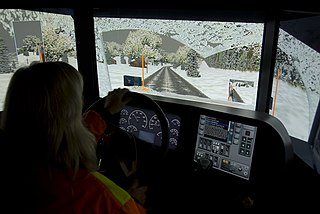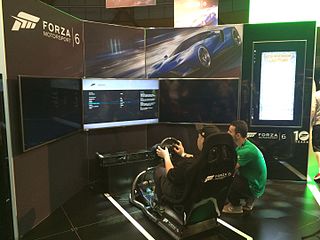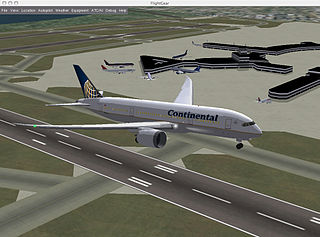
A flight simulator is a device that artificially re-creates aircraft flight and the environment in which it flies, for pilot training, design, or other purposes. It includes replicating the equations that govern how aircraft fly, how they react to applications of flight controls, the effects of other aircraft systems, and how the aircraft reacts to external factors such as air density, turbulence, wind shear, cloud, precipitation, etc. Flight simulation is used for a variety of reasons, including flight training, the design and development of the aircraft itself, and research into aircraft characteristics and control handling qualities.

A game controller, gaming controller, or simply controller, is an input device or input/output device used with video games or entertainment systems to provide input to a video game. Input devices that have been classified as game controllers include keyboards, mice, gamepads, and joysticks, as well as special purpose devices, such as steering wheels for driving games and light guns for shooting games. Controllers designs have evolved to include directional pads, multiple buttons, analog sticks, joysticks, motion detection, touch screens and a plethora of other features.

FlightGear Flight Simulator is a free, open source multi-platform flight simulator developed by the FlightGear project since 1997.

A Stewart platform is a type of parallel manipulator that has six prismatic actuators, commonly hydraulic jacks or electric linear actuators, attached in pairs to three positions on the platform's baseplate, crossing over to three mounting points on a top plate. All 12 connections are made via universal joints. Devices placed on the top plate can be moved in the six degrees of freedom in which it is possible for a freely-suspended body to move: three linear movements x, y, z, and the three rotations.

Simulated racing or racing simulation, commonly known as simply sim racing, are the collective terms for racing game software that attempts to accurately simulate auto racing, complete with real-world variables such as fuel usage, damage, tire wear and grip, and suspension settings. To be competitive in sim racing, a driver must understand all aspects of car handling that make real-world racing so difficult, such as threshold braking, how to maintain control of a car as the tires lose traction, and how properly to enter and exit a turn without sacrificing speed. It is this level of difficulty that distinguishes sim racing from arcade racing-style driving games where real-world variables are taken out of the equation and the principal objective is to create a sense of speed as opposed to a sense of realism.

A simulation cockpit, simpit or sim rig is an environment designed to replicate a vehicle cockpit. Although many pits commonly designed around an aircraft cockpit, the term is equally valid for train, spacecraft or car projects.

Driving simulators are used for entertainment as well as in training of driver's education courses taught in educational institutions and private businesses. They are also used for research purposes in the area of human factors and medical research, to monitor driver behavior, performance, and attention and in the car industry to design and evaluate new vehicles or new advanced driver assistance systems.
Combat flight simulators are vehicle simulation games, amateur flight simulation computer programs used to simulate military aircraft and their operations. These are distinct from dedicated flight simulators used for professional pilot and military flight training which consist of realistic physical recreations of the actual aircraft cockpit, often with a full-motion platform.

A motion simulator or motion platform is a mechanism that creates the feelings of being in a real motion environment. In a simulator, the movement is synchronised with a visual display of the outside world (OTW) scene. Motion platforms can provide movement in all of the six degrees of freedom (DOF) that can be experienced by an object that is free to move, such as an aircraft or spacecraft:. These are the three rotational degrees of freedom and three translational or linear degrees of freedom.
In physics, the degrees of freedom (DOF) of a mechanical system is the number of independent parameters that define its configuration or state. It is important in the analysis of systems of bodies in mechanical engineering, structural engineering, aerospace engineering, robotics, and other fields.

Six degrees of freedom (6DOF), or sometimes six degrees of movement, refers to the six mechanical degrees of freedom of movement of a rigid body in three-dimensional space. Specifically, the body is free to change position as forward/backward (surge), up/down (heave), left/right (sway) translation in three perpendicular axes, combined with changes in orientation through rotation about three perpendicular axes, often termed yaw, pitch, and roll.

Acceleration onset cueing is a term for the cueing principle used by a simulator motion platform.

D-BOX Technologies Inc., informally known as D-BOX, is a publicly traded haptic motion technology company based in Longueuil, Quebec. The company designs and manufactures motion and haptic systems for entertainment, simulation, and training industries. Combining haptic technology with actuators provides physical sensations in a virtual setting. As of July 2019, D-BOX seats were located at over 700 movie screens in 40 countries.
Wirth Research is a group of engineering companies, founded by Nicholas Wirth in 2003, specialising in research, development, design and manufacture for the motor racing industry and other high technology sectors.

A sim racing wheel is a control device for use in racing games, racing simulators, and driving simulators. They are usually packaged with a large paddle styled as a steering wheel, along with a set of pedals for the accelerator, brake, and clutch, as well as transmission controls. An analog wheel and pedal set such as this allows the user to accurately manipulate steering angle and pedal control that is required to properly manage a simulated car, as opposed to digital control such as a keyboard. The relatively large range of motion further allows the user to more accurately apply the controls. Racing wheels have been developed for use with arcade games, game consoles, personal computers, and also for professional driving simulators for race drivers.
SimCraft, a privately held company headquartered just outside Atlanta, Georgia, is the creator of a proprietary motion simulation technology and manufactures simulation equipment integrating this technology, including professional driver in the loop racing simulators. The motion simulator technology, in development since 1998, is designed to recreate the manner in which vehicles move in earth physics. The company offers a range of simulator products in the category of motion simulation that provide a tactile true motion experience for Motorsport Simulation and flight simulation. The company's core innovation and technology is the simulation of vehicle movement through proprietary physics based software interfaces and a patent pending hardware architecture based on Center of Mass principles of motion. The company's product applications range principally by variation in chassis design and material and are found in usage from military training/research, professional training, to individual simulation and gaming enthusiast entertainment.

A flight simulation video game refers to the simulation of various aspects of flight or the flight environment for purposes other than flight training or aircraft development. A significant community of simulation enthusiasts is supported by several commercial software packages, as well as commercial and homebuilt hardware. Open-source software that is used by the aerospace industry like FlightGear, whose flight dynamics engine (JSBSim) is used in a 2015 NASA benchmark to judge new simulation code to space industry standards, is also available for private use. A popular type of flight simulators video games are combat flight simulators, which simulate combat air operations from the pilot and crew's point of view. Combat flight simulation titles are more numerous than civilian flight simulators due to variety of subject matter available and market demand.

Simulator rides are a type of amusement park or fairground ride, where the audience is shown a movie while their seats move to correspond to the action on screen.
Cruden B.V. is a Dutch motion-based racing simulator designing and manufacturing company based in Amsterdam. Founders of Cruden have been developing professional motion simulators since the 1990s. Their experience in designing simulators for aerospace industry led them to use this knowledge to branch out into the marine, automotive and motorsport industries. Cruden is also branded as Hexatech.














